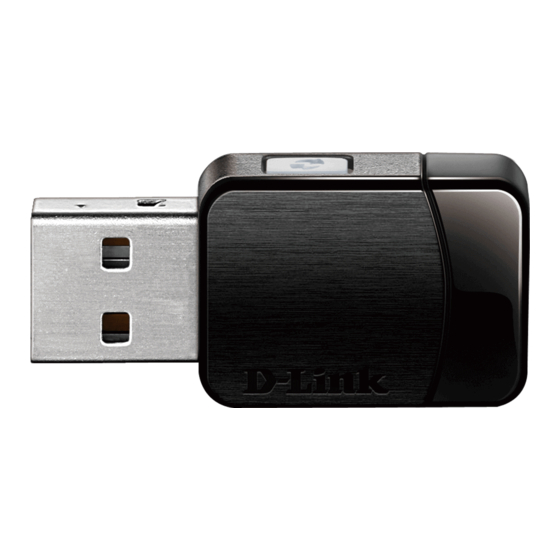Table of Contents
Advertisement
Quick Links
Advertisement
Table of Contents

Summary of Contents for D-Link AC600 MU-MIMO
- Page 1 AC600 MU-MIMO Wi-Fi USB Adapter DWA-171 Quick Install Guide...
-
Page 2: Package Contents
• An 802.11ac, 802.11n, or 802.11g wireless network • 20MB of free hard drive space Before You Begin Before installing your new D-Link wireless adapter, please verify the following: • Remove any previous installations of wireless adapters. • Disable any built-in wireless and/or Ethernet adapters. -
Page 3: Installation - Windows
Installation - Windows Installation ® Insert the DWA-171 into a USB port on your PC. The setup wizard should start automatically. Note: If the setup wizard does not automatically start, navigate a file manager to the virtual CD-ROM and double-click Setup.exe Follow the on-screen instructions in the setup wizard. -
Page 4: Connect To Your Wireless Network
Connect to Your Wireless Network There are two ways to connect to a wireless network: A. Wireless Utility - Connect to your wireless network using the wireless utility method. B. WPS Setup - Use if your wireless router supports WPS (Wi-Fi Protected Setup). Simply press the WPS button on your adapter and your router to automatically configure and connect. - Page 5 B. WPS Setup Connect to your wireless network using the WPS button setup method. Press the WPS button (or launch the WPS process) on your wireless router or access point. Please consult your router or access point’s user manual on how to start the WPS process.
- Page 6 Notes...
- Page 7 Notes...
-
Page 8: Technical Support
May 18 2018 6WA171C...01G ©2018 D-Link. All Rights Reserved. D-Link and the D-Link logo are trademarks or registered trademarks of D-Link. All other third-party marks mentioned herein may be trademarks of their respective owners. Maximum wireless signal rate derived from IEEE Standard 802.11ac, 902.11a, 802.11g, and 802.11n specifications. Actual data throughput will vary. Network conditions and environmental factors, including volume of network traffic, building materials and construction, and network overhead, lower actual data throughput rate.






